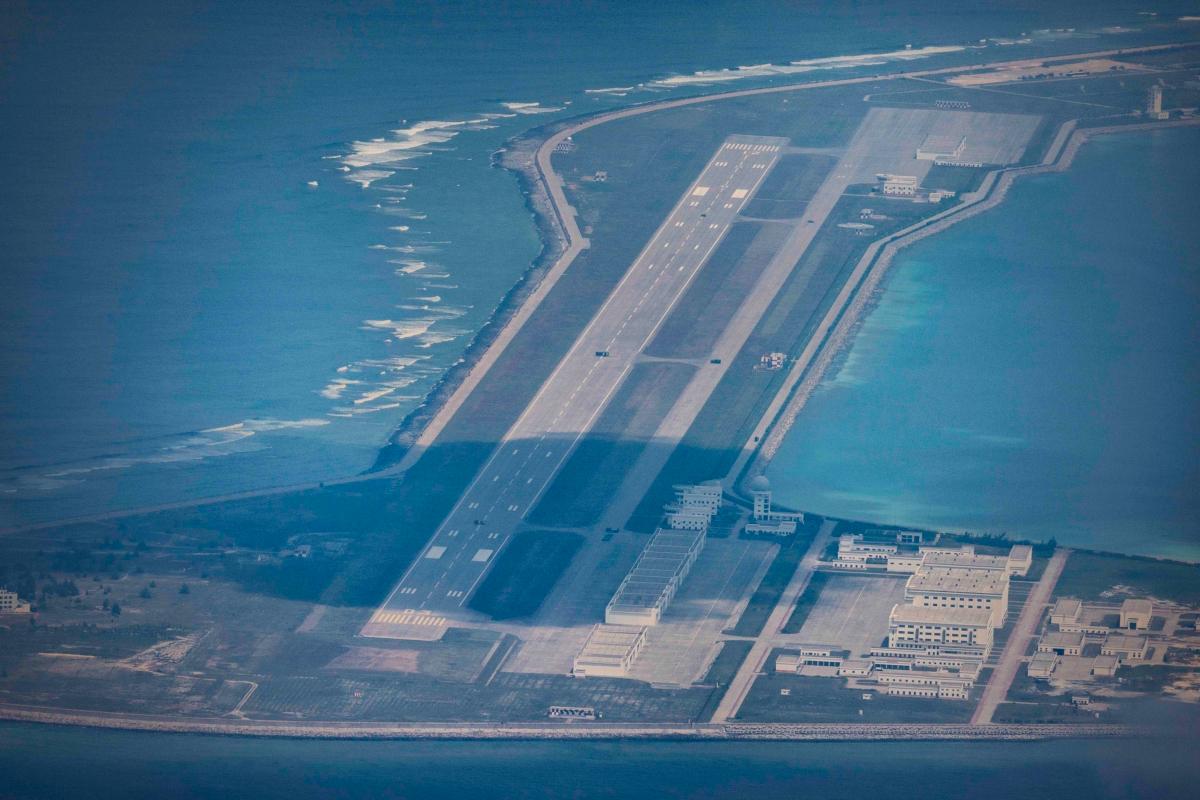“We can totally debunk the lie and disinformation by the People’s Republic of China that they have already occupied the Pagasa cays,” Philippine Coast Guard spokesperson Commodore Jay Tarriela told reporters on April 28, referring to a group of small islands also known as the Sandy Cays.
On April 26, Chinese state broadcaster CCTV broadcast images of khaki-clad China Coast Guard officers unfurling the CCP flag to proclaim control over Sandy Cay Three in mid-April. The Philippines occupies the nearby Thitu Island, or Pagasa Island, which, according to the U.N. Convention on the Law of the Sea (UNCLOS), means that nearby features such as Sandy Cay, which the Chinese call Tiexian Reef, are part of the Philippines’ sovereign territory.
On April 27, six Filipino officers landed on the uninhabited sandbars of cays one, two, and three of Sandy Cay to show the Philippine public that the CCP had not gained permanent control or built any structures or installed or monitoring devices, contradicting its claims.
“So it is to the interest of the PRC if they’re able to utilize the information space to intimidate and harass. This is also one form of gray zone operations on the part of the PRC. … So we’re here to debunk that and assure the public that we have not lost the Pagasa Cays.”
He also called on the CCP and the China Coast Guard to “maintain the status quo” and “act with restraint and not increase tensions in the West Philippine Sea.”
“It is not to the benefit of any nation if these things are happening, nor is it to the benefit of any nation if such irresponsible announcements and statements are released to the public and to the world.”
Responding to the Philippines’ operation, the China Coast Guard on April 27 claimed that the Philippines had “violated China’s territorial sovereignty.”
China Coast Guard spokesperson Liu Dejun demanded that the Philippines cease its landings “immediately” and that the China Coast Guard would continue to “carry out law enforcement activities” within waters that are part of its jurisdiction.
The 92 acres of Thitu Island and the five sandbars of Sandy Cay make up the Thitu Reefs. Manila currently holds de facto sovereignty over both features of the reef under UNCLOS due to its decades-long occupation of Thitu Island, which it calls Pagasa.
Both Thitu Island and Sandy Cay are classified as rocks under UNCLOS, as they remain above water at high tide. The 2016 Hague Tribunal ruling in Philippines v. China outlined that states are entitled to 12 nautical miles of sovereign territory around “rocks,” which extends to the airspace above and the seabed below. Sandy Cay lies just five nautical miles west of Thitu Island.
Information Warfare
Tarriela told reporters that while the Philippines is actively monitoring its seas to make sure that the CCP does not cross Manila’s stated four red lines, the public also needs to be aware that the CCP is playing the game of information warfare.He said with the recent claims about seizing Sandy Cay, China was planting misinformation, “convincing the international community that they have already seized Pagasa Cays one, two, and three.”
Rear Admiral Vincent Trinidad, spokesperson for the Armed Forces of the Philippines (AFP) in the West Philippine Sea, said the CCP has been using these tactics against the Philippines for decades, since 1992. “Their illegal presence, coercive, and aggressive actions, and deceptive messaging have been in play since 1992 up to the present.”
He said this recent disinformation operation was to counter the joint Philippine-U.S. Balikatan military drills.
“Explain the check,” Malaya told China. “You know blanket denials will not do. … Rather than doing these things, they should explain to the world and to the Filipino people why they are interfering in the internal matters of the Philippine government, of the Filipino people.”
As to any risks regarding the CCP occupation of Sandy Cay, Trinidad said, “The AFP has been very strongly monitoring our maritime domain, not only in Sandy Cay. Any action that will go beyond the current status quo will, and as has already been declared, a red line, especially when it comes to reclamation and building activities.”
He added that the cay that China landed on, which was actually Sandy Cay Two, is within 1.8 miles of Thitu Island and within monitoring of the military base there.
CCP Wants Control
China observers have long voiced concerns that the CCP was planning a land grab at Sandy Cay.China has been “watching Sandy Cay” for a long time, Philippines’ ambassador to China, Chito Santa Romana, has warned.
The past decade has seen the two nations locked in an ongoing tussle over the sliver of sand that remains above water because of what it means for territorial claims in the region under UNCLOS, even though China has ignored international law under UNCLOS in many other instances across the South China Sea.

Then, in 2019, another swarm of around 275 Chinese fishing ships appeared in the waters around Thitu Island, reportedly blocking Philippine access to Sandy Cay like they did when they wrestled control of Scarborough Shoal in 2012.
In response, the Philippines declared that the Chinese vessels were in violation of its “sovereignty, sovereign rights, and jurisdiction.”

As a low-tide elevation, Subi is not a rock and therefore generates no territorial sea of its own.
If the Chinese regime wrestles control of Sandy Cay from the Philippines, the rock could see China lay its own 12 nautical mile territorial claim that would include Subi Reef—although such a claim would still overlap with the Hague’s ruling that Subi is within the Philippines EEZ and continental shelf.
The Philippines says China’s artificial island building at Subi is illegal under UNCLOS and in violation of the Philippines’ exclusive rights to exploit the resources in its EEZ and continental shelf.
The Philippines, China, Taiwan, and Vietnam all have overlapping claims to Subi.

Militarized Subi Reef
The Chinese have occupied Subi since 1988 and began works to dredge, reclaim, and militarize the reef in 2014. Its artificial reef-building at Subi and other reefs was also criticized by the Hague for causing permanent ecological damage to the nearby coral reefs, in violation of China’s obligations under UNCLOS, specifically Articles 192, 194, and related provisions to protect and preserve the marine environment.All states with claims to the Spratly Islands, except Taiwan, have ratified the UNCLOS: the Philippines in 1984, Vietnam in 1994, and Brunei, China, and Malaysia in 1996.
Despite this, Beijing maintains that the Hague ruling has no legal basis and continues to assert many of its contested historical claims in the South China Sea.
Military Drills
The CCP’s claims to Sandy Cay coincide with the United States and Manila’s launching their annual joint Balikatan, or “shoulder-to-shoulder,” military drills on April 21, with the exercises said to be in preparation for a “full-scale battle scenario.” This drew criticism from Beijing, which called them “destabilizing” amid what the Philippines and other U.S. allies consider aggressive actions by the CCP.“It’s joint training with the U.S. forces to increase our capability in securing our territory and, of course, it will increase our capabilities and our preparedness and responsiveness to any eventuality,” Philippine army Maj. Gen. Francisco Lorenzo said of the drills.
“All of us want to resolve any regional conflict peacefully but should deterrence fail, we need to be prepared,” U.S. Marine Corps Lt. Gen. James Glynn said.
The drills last through May 9.
In early April, China and Cambodia held their own joint military drills at the newly expanded Ream Naval Base on the coast of the Gulf of Thailand.







